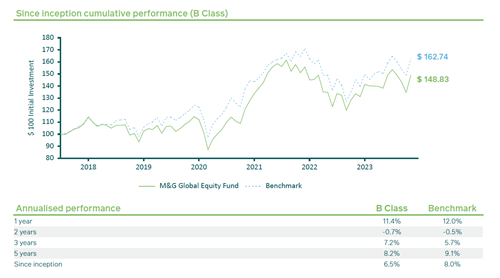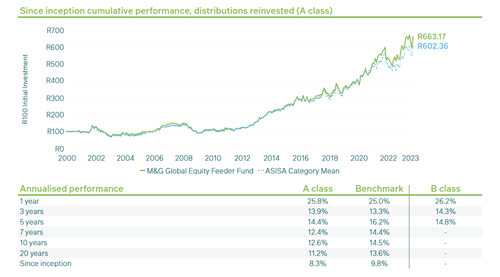Table Talk: Local investors enjoyed strong global equity returns in 2023. Where to from here?
Q: At the start of 2023, I reduced my global equity exposure as market expectations were largely that it would not perform well against the backdrop of macroeconomic challenges. Having missed out on the solid returns that global equity investors enjoyed in 2023, how can I incorporate this asset class into my portfolio moving into 2024 without taking on undue risk?
A: As 2022 came to a close, the outlook for equity markets – both local and global – was not promising. The macroeconomic outlook was faced with significant challenges -- stubbornly high inflation, ever-increasing interest rates, geopolitical tensions (namely Russia’s invasion of Ukraine earlier in the year) and its negative impacts, as well as fears of a looming global recession -- all fanning negative sentiment and predictions for equity markets going into 2023.
Contrary to what many had anticipated, most equity markets are in positive territory as 2023 comes to a close. The prospects of interest rates having reached their peak and the recession seemingly averted have boosted confidence and sentiment, which is evident in equity market performance for 2023 thus far. Despite high levels of volatility, global equity has delivered 17% (in USD – MSCI ACWI Index) and 30.1% (in rand) for the year to date (30 November 2023).
US equity was a large driver of global equity returns this year. However, outsized returns in the US market have been highly concentrated, which means that there could still be very good opportunities there for active investors who are willing to dig a little deeper. Looking back at the first six months of 2023, the S&P 500 Index was up by nearly 16%, and by the end of November, the S&P 500 had posted a total return of 21%, largely the result of gains in technology stocks, the “Magnificent 7” mega-caps (Apple, Amazon, Alphabet, Nvidia, Meta, Microsoft and Tesla), on the back of growth prospects from their increased application of AI.
Local investors would have been particularly well-positioned in global equity, not only due to markets being in positive territory but also the depreciation of the rand against the major global currencies which further boosted returns. The rand has lost 11.6% versus the US dollar for the year to 30 November 2023.
Selectivity required in 2024
While the risk of an economic downturn in 2024 could put global equities under pressure, we believe that being selective will be key, especially by focusing on companies that are able to benefit from longer-term structural growth drivers, rather than those with more cyclical exposure. There is evidence of a return to greater value dispersion across stocks globally, even within the same sectors, providing support to an active investment approach as we head into 2024.
For South African investors, global equity can act as a strong diversifier of local SA-specific risk and important building block in a portfolio. For those looking to add global equity stocks to their portfolio, rather than trying to do research themselves on the thousands of global companies available to choose from, they should consider investing in global equity unit trusts, such as the M&G Global Equity Fund, which provides tremendous diversification across different regions and sectors.. Such funds are managed by professional portfolio managers who actively seek to mitigate the downside risk and capitalise on the opportunities presented by global equity markets.
The M&G equity team managing the M&G Global Equity Fund, for example, has been navigating 2023’s narrow global performance (concentrated in the US) and taking advantage of the resilience of global economic growth amid ongoing interest rate pressure and geopolitical instability. They are able to analyse the thousands of stocks included in the global equity universe by using the vast power of artificial intelligence to help select stocks for the fund, an approach that has proved successful for more than six years.
Harnessing the power of man and machine to improve client outcomes
AI and machine learning have the potential to revolutionise the way we approach investing, and the M&G Global Equity Fund is at the centre of this revolution. Where the universe of investable shares is vast, we have found that incorporating machine learning into our global investment process allows us to analyse significantly more stocks at a much more detailed level and much quicker than a typical team of analysts would be able to cover.
Given that the vast amount of data being gathered is directly comparable across all the stocks being analysed, it gives us a significant advantage over traditional research methods. Ultimately, machine learning significantly augments the stock analysis component of the investment process.
We have successfully been using AI in our investment process, particularly in the research and modelling components, which runs through our comprehensive proprietary database with about 10 billion data points and 25-30 years’ worth of historical data. The output capacity of the AI is phenomenal in that the models are used to evaluate the prospects of about 10,000 companies on every listed stock exchange in the world on a daily basis. The database is used to train our models in order to understand the relationship between underlying data and share price performance. The output provides a streamlined view of the best ideas and gives what we call an ‘alpha score’ upon which we conduct further research and human oversight and overrides before constructing a portfolio.
For every stock that triggers a ‘buy’ recommendation in the AI, we leverage the deep technical expertise and fundamental capabilities of over 400 investment professionals globally, before making the decision to trade. Human overrides provide a filter to the buy list in applying expertise and deeper understanding that an AI may overlook.
For example, a Chinese educational services company called Tianli started to flag as attractive in the summer of 2021. Through conversations with one of the analysts on the M&G Asia team, it became evident that there was impending regulation that had the potential to disrupt the business model of companies like Tianli involved in the Chinese private education industry. Furthermore, because of the unquantifiable nature of the impact, analysts had not changed their price targets or ratings prior to the event. When we went down the checklist of things we might look for while overriding model recommendations, the binary nature of the impact along with stale analyst estimates were clear red flags. With the help of human oversight and overrides, we avoided investing in Tianli, whose share price has halved since then.
At M&G, we are deliberate in combining both aspects of human and machine intelligence in our investment process and strategy. We appreciate that there are certain qualitative factors that cannot be captured in AI models – the model wouldn’t know if there was imminent disruption to a company or an industry from something like government regulation. Human oversight remains a key component throughout the process, from building the database and modelling the data all the way down to stock selection.
Performing well over three years of exceptional volatility
In recent years, some unprecedented events have transpired that have underscored the importance of human oversight in the AI-backed investment process. From the COVID-induced market crash in March 2020, to one of the best years in equity performance in 2021, to a complete reversal for equities in 2022.

Acknowledging the challenges to forecasting economic cyclicality, the AI-based strategy implemented early in 2020 in the M&G Global Equity Fund was designed to focus on selecting stocks within countries and industries that could outperform their respective indices regardless of the macroeconomic environment. This approach, coupled with the team’s solid investment expertise, has helped the Fund deliver cumulative outperformance throughout this recent period riddled with extraordinary challenges and market volatility in both up and down markets. This has tested and proved the robustness and repeatability of our AI model and the overall investment process in navigating the complexities of global equity markets. As graph 1 demonstrates, the Fund has outperformed its benchmark (the MSCI ACWI Index) over the three-year period to 30 November 2023 with a return of 7.2% p.a. versus 5.7% p.a., while delivering 6.5% p.a. since its inception in June 2017 compared to 8.0% from the benchmark (all in US$).
For some investors who have not utilised their full offshore allowance, can consider the rand-denominated M&G Global Equity Feeder Fund, which has delivered returned 25.8% (in rand; A class; net of fees) for the 12 months to 30 November compared to 25% from its benchmark, while over three years it has outperformed, returning 13.9% p.a. (in rand; A class; net of fees) versus 13.3% p.a., as shown in graph 2.

So, when adding global equity exposure to a portfolio, it makes sense to consider a global equity unit trust managed by experts, given the vastness of the investment universe. Unit trust funds like the M&G Global Equity Fund and M&G Global Equity Feeder Fund can add valuable diversification and growth potential to a local portfolio using a unique but proven investment process that harnesses the power of both human and machine learning to deliver value to investors.
Share
Did you enjoy this article?
 South Africa
South Africa Namibia
Namibia




 Get the Newsletter
Get the Newsletter